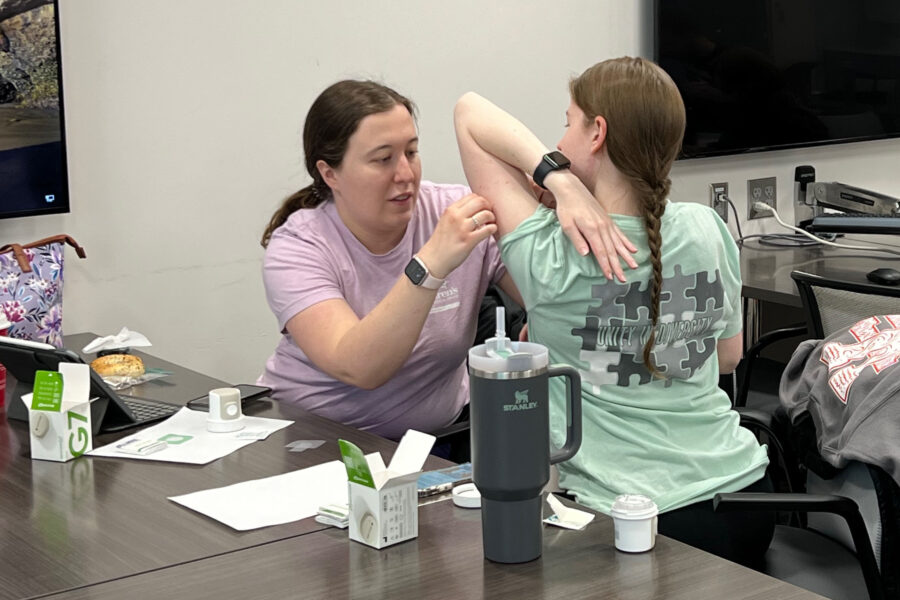Third-year pharmacy students in the UNMC College of Pharmacy’s diabetes management elective learn the science of the disease. But the course also teaches something perhaps just as important for future pharmacists to know.
“Empathy is a big thing,” when dealing with patients who live with diabetes, said Jessica Downes, PharmD, clinical associate professor of pharmacy practice and science.
“It’s very easy to see a patient and say, ‘Why are you not checking your blood sugar?’” Dr. Downes said.
So, pharmacy faculty might have their students find out why, by having them prick their own fingers, up to four times a day.
“And once you’ve lived that experience, a light goes off,” Dr. Downes said. “Oh, it’s painful and not fun, and burdensome.”
“There is so much self-management that patients have to go through and deal with day to day,” agreed Kristen Cook, PharmD, clinical associate professor of pharmacy practice and science. “We give (our students) a little taste of that.”
A “Living with Diabetes” experiential learning emphasis shows students taking the course that it takes more than focusing on blood sugar and A1c targets to be successful at diabetes management.
After taking a try at “living” with the condition, these students are now better able to understand their future patients. And patients are more likely to respond to pharmacists who show they have some idea of what their patients are going through.
But as technology has evolved for diabetes patients, so has it for Dr. Cook’s and Dr. Downes’ students. P3s studying the diabetes management elective now wear continuous glucose monitors or CGMs. They also keep food diaries, calculate the amount of insulin they think they will need and “plan” (know it’s always a possibility) for an unplanned hospitalization in case of miscalculation or crash.
Though technology has improved, new technology also brings new challenges, students learned. “We had people who did not set their alarms properly, and it would go off in the middle of class,” said P3 Jackson Stensgard. The result? “Social anxiety,” he said.
Stensgard said he’d rather take an awkward alarm going off in public over passing out. But the truth is at least some diabetes patients choose to gamble against the latter.
Where before a patient might not want to prick their finger, now, they may not monitor their levels as closely out of fear of embarrassment. That may not make medical sense to future pharmacists, but …
“When you think about it as a human being …” Stensgard said.
“Until you are actually in their shoes, you don’t know what you don’t know,” Dr. Downes said.
Meredith Ollerich, another third-year pharmacy student, said she was surprised to see how her blood sugar changed after different meals – and often in ways she found counterintuitive. A heavy-carb meal might not make a dent. “But after a small-carb meal, my blood sugar would spike,” she said. That made it tougher to plan than she’d thought, even as someone who was carefully keeping track.
All of this can be a lot for patients to manage. “It can be overwhelming,” Dr. Downes said.
And it’s good for their pharmacists to know that.
Some pharmacy students said they didn’t even notice the CGMs once they were on. But other people in their lives did (one student’s puppy certainly did, nipping at the device). And there can be a psychosocial aspect of knowing that people notice that you’re different in some way.
But Stensgard took it as a positive. He said people living with diabetes noted that he also was wearing a CGM when he worked the pharmacy counter. They appreciated that he was trying to understand what it was like for them, even if it was just a school project.
Following the experiential portion of the class, 15 of 20 students reported that they will care for patients with increased empathy. Thirteen reported realizing that an unexpected hospitalization would be distressing. Many also now understand that a diabetes diagnosis may have an impact on interpersonal relationships.

As a parent of two Type 1 Diabetic children, I am very pleased to learn of this program. The pharmacist is an integral part of the care team for any diabetic patient and cannot be overlooked. We appreciate your efforts!
Fantastic! I’ve started wearing a CGM to help me determine trends and what activities or foods cause spikes. It is very eye-opening. I was a student when the first finger stick blood glucose machines came out (they were about the size of a laptop case). We checked our blood sugars on our IM rotation and have always followed the tech. Pharmacists are so perfectly placed to help diabetic patients and the more informed and experienced the better.